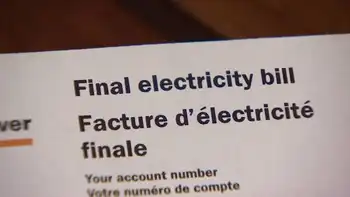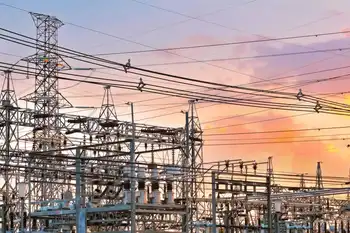Solar pitting green versus green
By Reuters
NFPA 70e Training
Our customized live online or in‑person group training can be delivered to your staff at your location.

- Live Online
- 6 hours Instructor-led
- Group Training Available
"Wow," he remembers thinking at the time. "God made this to be a solar farm."
But when Kim Williams looks out at that same land from her low-slung ranch house, she sees an area rich with wildlife that is helping support her grass-fed chicken farm, her neighbor's cattle operations and her peaceful way of life. She supports solar energy on a small scale — the electric fence around her chicken coop is powered by solar — but says when she learned about the solar plant she felt shock and disbelief. Now, she's suing to block it.
The push to create an alternative to carbon-based fuel has hit an unlikely snag: environmentalists.
The split between Peterson and Williams illustrates this awkward state of affairs. To a growing number of environmental advocates, the dozens of large solar plants that are springing up in vast areas of the western wilderness are more scourge than savior.
The upshot is that those who on paper seem to be perfect allies for solar are turning into its biggest enemies.
That includes the Sierra Club, which recently filed what senior attorney Gloria Smith says is its first suit against a solar plant, a giant 664-megawatt project called Calico that is slated to go up in the desert near Barstow, California. It would lie smack in the middle of habitat for rare plants and animals, in an area Smith calls "a very unfortunate site."
The legal brawl comes as the U.S. is racing to adopt renewables. In the United States, renewable energy, including solar, makes up just 8 percent or so of electricity generation, according to the U.S. Energy Information Administration. That figure was expected to jump to 13 percent by 2035 — but that was before the Green vs. Green feud.
Even though Williams and her cohorts support the broad goal of reducing dependence on fossil fuels, they say it comes at too high a cost if it means building on undeveloped land. Helping their case: the proposed plants are often slated for areas with threatened or endangered animals, including kit foxes, kangaroo rats, rare lizards, and others.
Now, the groups have gone from complaining to litigating. That means solar companies must take funds and management time that would have been spent on developing their plants and spend them instead on fighting lawsuits. For some companies, the likely result is that plants won't be built.
For the solar industry overall, the situation marks a fundamental shift in attitude. Where previously almost any bare patch of desert seemed like a prospective solar plant, now the reality is that much of the nation's most fertile ground for alternative power and energy independence may well remain undeveloped.
And the backlash is likely to slow down the number of big plants developers will try to get through. Some 142 U.S. solar plants are under development, according to the Solar Energy Industry Association, up from just 28 two years ago. Many of these are well over 500 megawatts a handful are over 1,000 megawatts, meaning they would cover hundreds of acres of land and power at least 300,000 homes each.
The big plants give the U.S. a chance to gain ground in the solar power industry, where it lags countries like Spain, which has around 30 large-scale solar plants in the construction phase. China, which dominates the solar panel business, is also racing ahead, with an aggressive renewable-energy policy and big loans to companies.
Solar energy is among the strategic industries in which China is considering investing up to $1.5 trillion over five years to cement its position as a provider of high-value technologies.
In one major project, China's Shandong Penglai Electric Power Equipment Manufacturing Co. is working with Burbank, California-based eSolar to build a series of plants totaling 2,000 megawatts of electricity in the deserts of Northern China. Some 60 miles away, Tempe, Arizona-based First Solar is working on the first stage of its own China plan, a 2,000-megawatt project.
Analysts say the prevailing view in China is that the good done by solar plants outweighs any damage they may do to the environment, and concerns about plants and animals are minimal. Not so in the United States.
California lies at the center of the U.S. solar industry, thanks to a confluence of sunlit land and a legal requirement for 33 percent of its electricity to come from renewable sources by 2020. More than 40 solar utility plants are in development, according to the state's public utilities commission. Almost all of them have or will run into problems with environmentalists or people who simply don't want the plants in their backyard — plants like Peterson's Solargen.
The company was born in 2006, as the government was bolstering its support for the solar sector through tax credits and loan-guarantee programs. Peterson, the company's chief executive, was among those who bought in. Previously, he had advised high-net worth individuals at Goldman Sachs, and later founded and managed an alternative-energy investment firm.
But the Solargen executives weren't the only ones who had spied opportunity. The Solargen team figured it could never compete with the hordes of developers focusing on the deserts, where too many projects were chasing too few power lines to carry all the electricity they would generate. Fewer companies were looking in central California.
When Peterson first saw Panoche in 2008, he said he felt he had hit the jackpot: a 20,000-acre valley with few inhabitants that seemingly no other developers had their eye on. While most other utility-scale plants are planned for government-owned property, this land was privately owned — which Peterson assumed would make the permitting process easier.
He quickly moved in, figuring out who owned the land he would need — both for the plant and a preserve to mitigate loss of habitat for animals and plants on the site — and enlisting local movers-and-shakers to help him get it. He recalls negotiating with one rancher who kept a shotgun at his side for the entire meeting another unsuccessfully kept trying to ply Peterson, a Mormon who doesn't drink, with spirits.
Meanwhile, he was trying to nail down funds. That's been tough for almost all solar energy companies, particularly startups, in a climate where investor cash has slowed to a trickle. The more innovative the technology, the harder it has been to line up financing. Many companies are trying to tap into loan guarantees on offer from the U.S. Department of Energy, but the application process is lengthy and rigorous. Peterson says his application was turned down.
Trips to Silicon Valley's fabled Sand Hill Road got him nowhere. Venture capital investment has declined overall, but clean technology has been particularly hard hit. Just $625 million was invested in the sector in the third quarter of 2010, the National Venture Capital Association says, compared to $1 billion two years ago.
Peterson's then limited experience in solar energy didn't help. And the founder of Solargen, Eric McAfee, had landed in hot water with the Securities and Exchange Commission, which found he had caused drilling company Verdisys to make misleading disclosures about its expenses and revenues. In 2006, McAfee agreed to pay a $25,000 civil penalty without admitting or denying the SEC's allegations. Peterson calls McAfee, chairman and CEO of ethanol company AE Biofuels, "a leading thinker in renewable energy" who regularly addresses forums such as Milken Institute conferences, and adds that the SEC never filed any restrictions against McAfee.
Desperate for financing, Peterson finally dusted off the Mandarin he had learned as a Mormon missionary to Taiwan in the early 1980s, and went back for several visits. He can still rattle off the greeting with which he began each meeting — describing how much he enjoyed his time in Taiwan, how glad he was this project has brought him back, and how sorry he was about his rusty language skills.
One company he hit up was UMC, which had founded NexPower Technology Corp., a thin-film solar manufacturer. To seal the deal with its investment arm, Peterson agreed to buy some panels from NexPower for the plant as long as he can find a lender willing to finance a project using those panels.
The gambit worked. He won investments from UMC Capital, his largest backer, and Chinatrust Venture Capital, amounting to $6.5 million. Altogether, Solargen has raised close to $12 million, Peterson says. Building the plant will cost a total of $1.3 billion, he estimates.
While Peterson was lining up financing, however, some Panoche Valley residents were lining up against the plant, which they learned about in the summer of 2009 after a Pacific Gas & Electric representative mentioned it to Ron Garthwaite, a local dairy farmer.
"It was kind of hard to get our minds around," says Williams, who moved to the Valley from San Francisco a few years ago after reading sustainable-agriculture bestseller "The Omnivore's Dilemma" and deciding she too could raise chickens.
Solargen's plans to put the plant on just a small portion of the valley, allow sheep to graze beneath the panels and buy property and easements to set aside 20,000 acres of land in and near the valley as nature reserves did nothing to alleviate her concerns.
She, Garthwaite and others like the Santa Clara chapter of the Audubon Society started organizing to fight it.
But where Williams was seeing red, the county was seeing green. Solargen has offered to pay a $1 million a year fee to the county for the life of its plant — a nice addition to a county where the annual operating budget runs around $40 million. And Solargen meant jobs — up to 200 during peak construction. The county approved the project.
"The majority of the population of my district supported it," says Reb Monaco, the outgoing member of the board of supervisors who represents the rural southern part of the county, including the Panoche Valley.
Those who didn't quickly dusted off a well-worn playbook: using environmental laws to fight a development project.
Lawyers say the moment state or local government approves an environmental plan offers the best opportunity to sue to block a plant, using the federal law known as the National Environmental Policy Act or state law such as the California Environmental Quality Act as grounds. Having threatened or endangered species of plants or animals on a site gives the suits far more heft, they say.
Save Panoche Valley, the organization Williams helped create, and its allies filed a lawsuit in November alleging that the county approved subpar environmental and water assessment reports and improperly canceled conservation agreements to keep the land in agricultural use. Threatened or endangered animals such as the San Joaquin kit fox, the giant kangaroo rat and the blunt-nosed leopard lizard receive special mention throughout the lawsuit. The county doesn't comment on allegations in pending lawsuits, said assistant county counsel Barbara Thompson.
Getting the permits rescinded is the ultimate goal, the groups say. But almost as good is simply delaying the process. "A long drawn-out one would be a victory too," says Garthwaite, who believes Solargen would simply run out of money and time to keep fighting.
If worst came to worst, Solargen could simply sell the project without developing it, says Christine Hersey, a solar analyst at Wedbush Securities who has been following environmental concerns closely. Because Solargen already has its land and most of its permits, the business has value, but would have more value if the company also had an agreement with a power company to purchase its electricity, something Peterson says he's working on.
Right now, the battle is in the hands of the county, which is preparing a response to the lawsuit ahead of a hearing scheduled for March. Peterson says he's worried the overhang will make it harder for him to raise his next round of funding — in particular, $7.5 million he needs to come up with by February as a deposit for a power line-interconnection study required by the utilities that own the lines he hopes to connect to.
Peterson's fears are well placed, says Hersey, the solar analyst at Wedbush. "Investors who were performing their due diligence would want those lawsuits resolved before they committed any capital," she says, speaking generally about the solar industry. And as more solar projects from a variety of companies wind their way through the approval process, litigation "will become a bigger issue," she says.
Among the plants she considers at high risk is First Solar's 300-megawatt Stateline project, which has high numbers of threatened desert tortoises.
Several other projects are already mired in legislation or under threat of it.
The Quechan Tribe, a Native American group centered around the border between Arizona and California, has sued the Bureau of Land Management over a 709-megawatt plant planned for its ancestral land in the Imperial Valley, citing animals such as the flat-tailed horned lizard. The tribe charges the BLM approval of the project didn't follow appropriate procedures. Last month, it secured an injunction blocking the plant, under development by NTR plc's Tessera Solar.
Just recently, La Cuna de Aztlan, a Native American advocacy group, and its co-plaintiffs filed a lawsuit over federal approval of six solar plants, citing the cultural environment, among other issues.
Among the six is the 370-megawatt Ivanpah plant in the Mojave Desert, for which BrightSource Energy broke ground in October. BrightSource already made some concessions after the Center for Biological Diversity, known for litigation on development it believes threatens the environment, raised concerns. The Tucson, Arizona-based group is keeping a close eye on other proposed solar projects, according to biologist Ileene Anderson.
In its suit filed in the Supreme Court of California, the Sierra Club sued the California Energy Commission over its approval of the Calico Solar Project. Among the Sierra Club's worries: the plant is going in an area rich with desert tortoises, which are threatened under federal law and endangered under California law, and other species. CEC officials "look forward to defending our position in court," said spokeswoman Sandy Louey. The developer, Tessera Solar, sold the project to New York-based K Road Power late last month.
Groups ranging from the Audubon Society to the Defenders of Wildlife to the Natural Resources Defense Council are also lobbing out objections against other projects.
About half of all plants in development now are having issues concerning plant and animal habitat, culture sites, or water demand, Hersey estimates. Many of those could end up in court. And just the threat of litigation seems likely to affect the scale of solar, analysts say. Developers could cut back the size of future proposed plants, and think more carefully about where they should go — and that's the point, environmentalists counter.
California has a handful of solar plants that date from the late 1980s, but the solar industry has only recently taken off in a big way. Fears over dependence on overseas fuel sources, a growing distaste for coal-powered electricity and generous government subsidies have all conspired to boost the industry.
Currently, the largest solar plant in the U.S. is just 160 megawatts — enough to power up to 50,000 homes. But BrightSource's Ivanpah at 370 megawatts just upped the ante. A stream of proposed plants is following in its footsteps, including a pair of 550-megawatt plants slated to break ground next year in San Luis Obispo County and Riverside County, and a 1,000-megawatt plant under development in Riverside County.
Of course, savvy operators can try to stave off legal action. Until the lawsuit by the Cuna de Aztlan, BrightSource had successfully taken this approach with Ivanpah.
One tactic is to go all out to protect plants and animals at risk. Solar companies can go above and beyond the requirements of the law, with extra-detailed studies of the species in question, extra-large purchases of land for use as preserves to offset ill effects at the site, and so on.
Solar Millennium is getting a lesson in going to great lengths with its proposed 250-megawatt Ridgecrest plant, mostly on private land in California's Kern County. Officials are worried about the effect on the Mohave ground squirrel, so Solar Millennium is considering whether to fund a two-year study to evaluate the squirrel population in the area. Phil Leitner, the independent biologist leading the study, says if the study goes ahead, he plans to trap squirrels, put radio collars on them, and take tissue samples from their ears to determine their genetic makeup.
Back in the Panoche Valley, the environmental reports and the permitting process have eaten up almost two-thirds of the money Solargen has raised. Among the bills: paying for scat-sniffing dogs to run up and down the hills, looking for traces of the endangered San Joaquin kit fox.
But not all the valley's residents are against the plant. "It's good for making work," says Mario Bencomo, 53, a ranch hand who says several unemployed friends are eager for jobs.
And naturally, many landowners want to see the plant go up, including San Benito County residents who live outside the Valley but own land there. Some have sold options on their property for the project — for prices of up to $2,600 an acre, according to a person familiar with the situation. Among them are Reprise Software vice president of operations Sallie Calhoun and her husband, Reprise chief executive Matt Christiano.
In addition to her Panoche Valley property, Calhoun also owns a ranch a few minutes' drive from the valley in the hamlet of Paicines. She uses sustainable grazing techniques there, chairs the board of a group that works to restore grasslands, and generally considers herself a steward of the environment.
She sees no conflict between her position on the environment and her support of the solar project. "I am passionate about preserving open space," she says, adding she believe the solar plant achieves that goal. "The idea that we're going to protect every lizard, every drainage, seems counterproductive."











